Tri-cone Bits Operating Guide
Section 1 - Rock Failure
1.1 - Rock Failure Mechanics
Efficient rock drilling requires an optimum combination of many factors, one of which is dynamic load, or an impact energy applied to the bit cutting structure.
Experiments proved that the depth of cut depends on the load applied to the insert. Figure 1 shows this regularity in a form of a polygonal line with 4 main areas of rock failure (a, b, c, d) under it.
Figure 2 illustrates the rock failure patterns in the process of penetration of one insert.
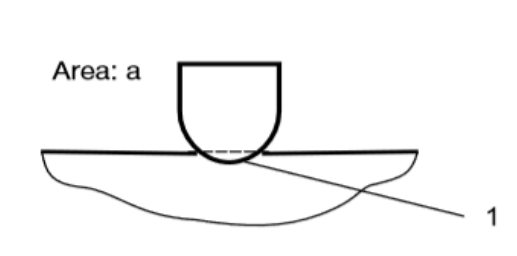
When only a minor impact energy is applied there is only minor fragmentation made by the insert on the rock surface (residual deformation). This results in the rock cracking around the insert contour.

With further increase in impact energy the rock starts chipping away from the insert contour. This is the first stage of rock failure. The force resulting in chipping around the insert contour is called the load of the first stage of rock failure.

The further increase in the impact energy up to the load of the second phase of rock failure results only in an insignificant increase in the volume of failure.
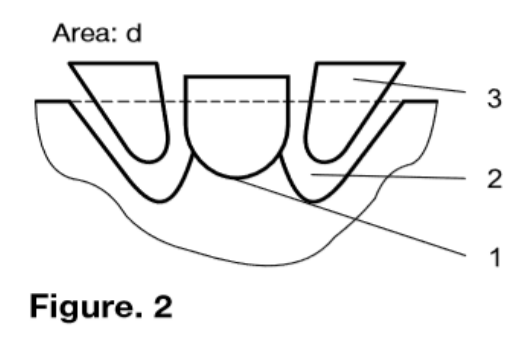
When maximum load is applied the volume of destruction increases proportionately. This type of failure is called the second stage of rock failure.
Figure 2 illustrates: 1 Insert-rock contact surface; 2 Rock failure crater; 3 Cutting cross section
1.2 - Selecting drilling modes
Conditions for b, d stage in rock failure
(Figure 1) depend on the properties of the rock, WOB, RPM and bottom hole cleaning conditions.
Optimization of drilling parameters is achieved through experimental selection of WOB and RPM. Specifications shown for WOP and RPM of the bit type should not be exceeded. In order to facilitate the most suitable cutting structure selection, please refer to Table R-1 “Rock Classification”. The table shows a variety of formations and their classification according to IADC code, strength coefficient as per the scale of professor M. Protodyakonov, drillability category, uniaxial compressive strength, etc.
Experiments proved the relation between the bottom hole penetration δ per one rotation and WOB while drilling with a rock bit. Figure 3 illustrates the relation as a curve.
Three main areas of rock failure are shown under it.

Area I
The rock is cut by abrasive wear, micro chipping, crushing and movement of some bottom hole irregularities. This area demonstrates insufficient WOB. ROP is not more than 3m/h.
Area II
Fatigue failure, voluminous chipping after several impacts on the same bottom hole area. Very hard formations are mostly drilled in this area. ROP is not more than 10m/h.
Area III
This is a bulk failure area where specific power inputs per unit of rock volume are considerably lower than in the first two areas but ROP is higher.
When RPM is modified, the quantity of insert impacts against the bottom hole per time unit changes. The penetration per one rotation (δ) can be expressed by ROP: ROP = n.δ
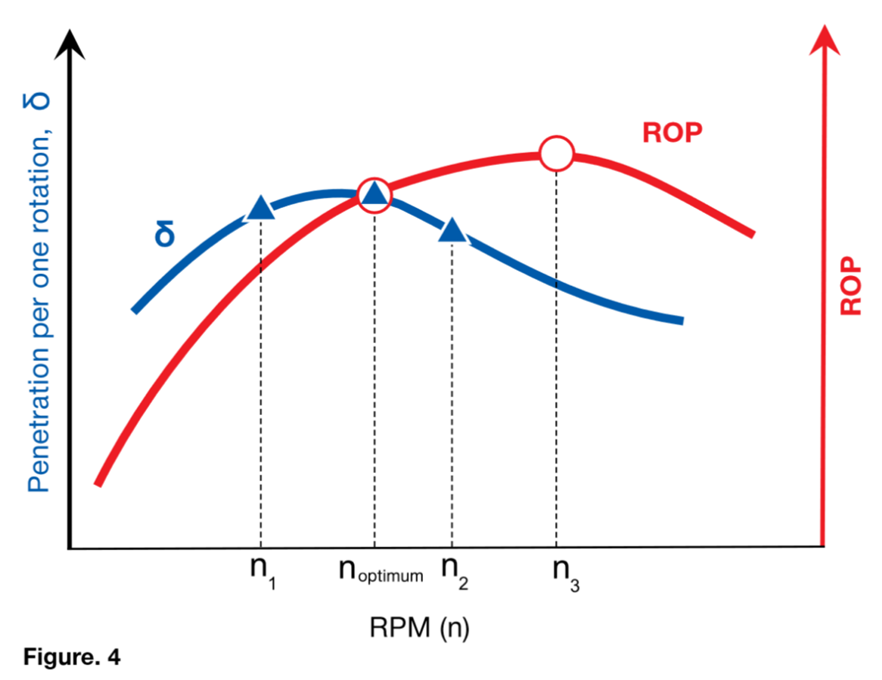
Figure 4 shows how bit penetration per one rotation (δ) and ROP depend on RPM. With increased RPM in n < n1 section, the values of ROP and δ increase. With increased RPM in n1≤n≤n2 section, δ decreases but ROP keeps growing. With further increase in RPM in n>n3 section, the values of δ and ROP decrease considerably.
ROP decreases after the point n3 due to:
- Reduced insert-rock interaction time;
- Decreased impact energy applied to an insert;
- Increased dynamic resistance of the rock drilled due to its plastic properties with little bit penetration per one rotation;
- Increased drilling rod vibrations;
- Changed mode of the air flow at the bottom hole;
- Increased power consumption.
Continuous air flushing while drilling ensures bottom hole clearing, the bit cooling and contributes to the efficient penetration into rock. An optimum ratio of the value of a bit penetration per one rotation δ and ROP on Figure 4 corresponds to bit RPM n opt. A further increase of RPM will result in erosion of the bit cutting structure and bearing with little further increase of ROP.
1.3 - Practical use of test results
The maximum ROP is determined experimentally for each bit type and size in given mining and geological applications. Therefore, an optimum ratio of WOP and RPM is theoretically achieved when the depth of cut is about 80% of insert protrusion. 20% remain for efficient cuttings removal. In practice the recommended drilling parameters for a particular bit type and size shall be determined using Tables K-1 and K-2. The target is to determine the maximum ROP with the given WOP and RPM. The maximum ROP value will correspond to the optimal WOP and RPM values.
Excessive WOB which makes depth of cut more than 80% results in the following:
- Cuttings will not be completely removed from rock cutting area;
- Rock is milled repeatedly;
- ROP decreases;
- Bit cutting structure and bearing wear intensively;
- Load on the drilling rig rotary head increases.
Section 2 - Air Circulation System
2.1 - Bottom hole cleaning

An optimum air circulation in up-to-date drilling with mining bits comes down to the following tasks:
1.To ensure efficient cuttings removal from bottom hole to the surface;
2.To reduce the erosive wear of cutting structure and bearings by means of efficient bottom hole cleaning.
3.To cool the bearing and to keep the bearing clean.
An efficient bottom hole cleaning objective comes down to obtaining the required annular return velocity.
The annular return velocity produces a lifting force that ensures cuttings removal. It can be controlled by:
- Selection of a compressor and its adjustment to the optimum air capacity;
- Selection of the rock bit diameter and drilling rod OD
- Selection of replaceable nozzles with optimum flow area and setting them in the bit.
Actual compressor capacity changes depending on the throttle flap position, wear of the screw pair and the compressor body, altitude above the sea level and manifold leakage.
Factors that affect the value of the annular velocity for cuttings removal:
- Correlation between the bit diameter and the drill pipe OD;
- Drilling rod gauge loss as a result of the wear.
- Rock specific strength.
- Sizes and shapes of cuttings.
- Water in the hole.
They can be expressed by the following formula: Q = 47 • V • (D2 b – D2 p)
Where Q is – air flow, m3/min;
V – is desired air velocity, m/sec;
It should be noted that:
- The air velocity for drilling light weight rock is to be more than 25 m/sec;
- The air velocity for drilling heavy weight rock is to be more than 35 m/sec;
- The air velocity for drilling heavy weight rock with high water content is to be more than 50 m/sec;
Db — is Bit diameter, m;
Dp — is Pipe Diameter, m;
2.2 - Required drilling rig compressor capacity
The required value of compressor capacity versus air velocity, rock bit diameter and drill rod diameter are shown in Table R-2.


The above calculation gives a preliminary estimate of required compressor capacity. The final data can be obtained only after a test drilling.
2.3 - Nozzles selection
Optimum combination of drilling equipment on a drilling rig (bit diameter, drilling rod diameter, actual compressor capacity) for given mining and geological applications makes it possible to achieve the required annular velocity and satisfactory bottom hole cleaning and cuttings removal. The better are the bottom hole cleaning and cuttings removal, the less is the erosive wear of the cutting structure and the bearing at maximum ROP. However, it is very important to realize that air circulation system is to ensure not only the required annular return velocity but to provide conditions for the best cooling and cleaning the bearing. This problem is solved solely by the choice of bit nozzles diameter, because only nozzles selection makes it possible to gain an air pressure drop in a bit which is required for successful drilling.
Recommended air pressure in a bit is determined in each case experimentally by making measurements with a special pressure gauge. The long-term experience in drilling blast holes reveals that the air pressure in a bit must be within the range of not less than 0.20 – 0.22 MPa (29.7 – 32.6 psi) and must match physical and mechanical properties of formations and drilling applications. Failure to observe the recommended values of air pressure in a bit will inevitably result in premature bearing failure.
2.4 - Nozzles replacement
Nozzles are fixed with a nail. The nail is installed in a groove in the leg and fills in the ring groove made in the leg and in the nozzle. Such method is the most reliable and facilitates nozzles replacement. Nozzles replacement procedure:
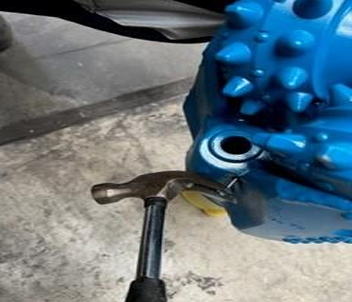


2.5 - On-site measurement of compressor capacity

Values obtained with this method are true only for Black Diamond bits when their air passages are free from cuttings. It is recommended to measure compressor capacity in the following order:
- Determine bit type and size and its condition. Only new bits or bits in good condition can be used.
- Determine the flow area of the nozzles. Be sure that all three nozzles are the same.
- When the compressor is switched on, check the air flow under the cones to make sure that all air passages are empty. The compressor should run with a nominal working temperature and with water supply switched off.
- Determine air temperature with the tools in the operator’s booth.
- Install a pressure gauge into one of the nozzles and measure the pressure.
- Basing on the corresponding bit and nozzle diameter find compressor capacity in the table.
The subject method makes it possible to measure an actual drilling rig compressor capacity on-site considering its wear, air circulation system leakage and other factors.
Compressor capacity chart

Section 3 - Guidelines to rock bit operation
Our recommendations will allow you to obtain good bit performance
Before drilling:
- Inspect the thread condition of the drill pipe drive rod. If the thread condition is unsatisfactory, the drive rod should be replaced.
- Inspect the drilling rod condition. Do not use Bent rods or a worn thread.
- Inspect the deck bush condition. Do not use worn deck bush.
- Inspect compressor based on the pressure gauge reading on the outlet as compared to its specification data. Get adjusted if necessary.
- Inspect the air ducts and hoses for leakage. Repair any faults found in the system.
- Inspect the control equipment. Replace faulty equipment.
- Inspect hoisting jacks. Do not allow losing the drilling rig horizontal position while drilling.
- Inspect the bit condition and state of the relieve valve, availability and size of nozzles, thread connection.
- Do not make unauthorized changes to the bit design by means of cutting or welding additional parts or removing relieve valve and nozzles.
- Flush the drilling assembly with air before screwing on the bit.
- Avoid impacts or shifts when screwing on the bit.
- Set the air pressure in the bit not less than 0.2 MPa by means of selecting the nozzles.
While drilling:
- Fill in the Bit Record Sheet for each bit.
- Break in a new bit for 15 minutes with the drilling rod rotation at 30 RPM and WOB of 10% of the upper limit recommended in the bit specification. Break in a new bit in a new hole it is recommended that new bits do not get started in broken ground (face holes).
- Smoothly apply the operation parameters recommended in the bit specification. Do not exceed the WOB and RPM indicated in the specification.
- If with sequential increase in WOB the ROP does not increase or decreases, then the WOB shall be reduced to the earlier registered level at which the maximum ROP was obtained.
- If the drilling rod starts vibrating, then the bit RPM or WOB shall be reduced to the level at which the vibration stops.
- Emergency stop and leaving a bit at the bottom hole with the compressor off may result in plugged bearing and cones jamming. To prevent its early failure, conduct the following control measures:
- Lift the bit off the bottom of the hole by 1.5-2 meters with no rotation. Turn on the compressor and flush the bit. While doing so, control the pressure increase in the drilling rig air line with a pressure gauge.
- Optimum drilling parameters shall be determined only by experiment. The most critical factor is the maximum ROP.
- Drill only with the compressor switched on.
- Do not apply weight on bit with no rotation.
- Do not drill when the bit cones are seized and do not rotate.
- Do not drill when the bit air passages are blocked.
- Do not run a new bit in an old hole. It can result in shirttail and heel row inserts cracking and cones jamming.
- Carry out tripping and hole conditioning only with the drilling assembly rotating and the compressor on.
- Do not use new or test bits to clean out collapsed holes. Always apply a used bit for this purpose.
- Pull the bit out of the hole, clean the bit, check cones rotations manually, turn the compressor on, and visually check flushing air through the cones.
- You can continue drilling with the bit if the bit examination results are satisfactory for the drilling rig operator.
- If the bit examination results are not satisfactory for the drilling rig operator, then the bit shall be removed.
After drilling:
Used bits intended for repair and drilling in the wells or for cleaning of choked wells shall be flushed and cleaned from mud, their bearing and thread shall be lubricated. It is not recommended to use new bits in repair operations.
Dull bits intended for scrapping shall be:
- Examined by the drilling rig operator and registered in the bit registry.
- Drilling report is forwarded to the engineer for registering the bits and analysing Bit Performance Statistics.
- A report on dull bit performance statistics including meters drilled, hours in use is recommended to be delivered to the manufacturer.
Section 4 - Dull Bit Analysis
Broken Teeth (BT)

Examination: Teeth break flush to cone body.
Causes:
- Too high RPM.
- Broken, disintegrated formation while drilling.
- Improper bit.
- Alteration of formations.
Recommendation:
- Reduce the RPM.
- Drill sections interbedded with very hard formations with reduced WOB and RPM.
- Select a bit with the cutting structure features fitting the drilling conditions.
Chipped Teeth (CT)

Examination: Chipped tungsten carbide inserts.
Causes:
- Excessive WOB.
- Broken, disintegrated formation whole drilling.
- Wrong TCI grade.
- Cone interference.
Recommendation:
- Revise the drilling applications and WOB.
- Reduce WOB and gradually reduce RPM.
- Select a bit with more wear resistant TCI.
Lost Teeth (LT)

Examination: TCI fall out of the cone body
Causes:
- Metal on the bottom of the hole
- Cone erosion.
- A crack in the cone that loosens grip on the insert.
- Excessive WOB.
Recommendation:
- Reduce WOB and gradually reduce RPM.
- Select a bit more suitable to the application.
Worn Teeth (WT)

Examination: Inserts wear blunt. Slow penetration rates.
Causes:
- Excessive WOB.
- Carbide grade does not match the rock properties.
- Formations changed and are interbedded with hard abrasive stringers.
- Excessive RPM.
Recommendation:
- Reduce WOB and RPM.
- Select a bit with another shape of inserts and a more wear resistant carbide grade.
- Select a bit that is more suitable to the application.
This dull characteristic can be considered normal if the meterage and durability values are high.
Heat Checking (HC)
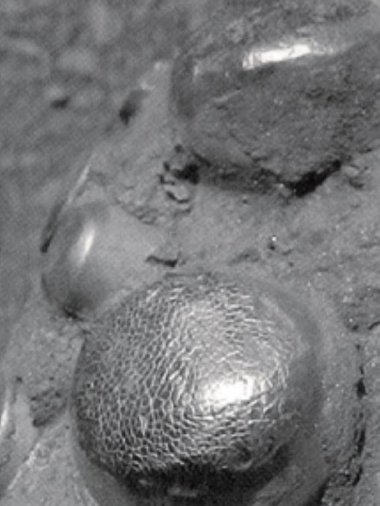
Examination: Inserts surface is worn and looks like a “snake skin”. Can result in insert breakage.
Causes:
- Carbide grade does not match the formations drilled.
- Inserts are heated by drilling process and at the same time are cooled with water, injected into the well with air and by underground water.
Recommendation:
- Select a bit with carbide less prone to heat checking (higher cobalt content or bigger grain size).
- Reduce RPM and water supply.
Rounded Gauge (RG)

Examination: The gauge inserts are rounded towards the center of the bit. Slow penetration rates.
Causes:
- Excessive RPM.
- Carbide does not match the formation hardness.
Recommendation:
- Reduce RPM.
- Use a bit with more resistant carbide grade.
- Use a bit with less offset and a bigger journal angle.
Tracking (TR)
Examination: Inserts are worn mainly on one side. This is a dull characteristic that occurs when the inserts mesh like a gear into the bottom hole formation.
Causes:
- Improper WOB and PRM.
- Improper bit selection.
- Changes in the formation.
Recommendation:
- Adjust WOB and RPM so that the proper rock cutting within a certain time period is achieved.
- Select a bit better suited for the application or a bit with an irregular skip patch.
Self-sharpening wear (SS)
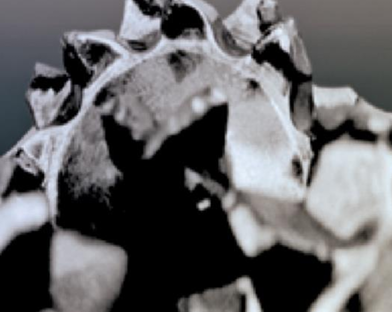
Examination: This is a dull characteristic hat occurs when the inserts wear in such a way that they retain a sharp crest shape. This proves proper selection of bit and operating parameters.
Erosion (ER)
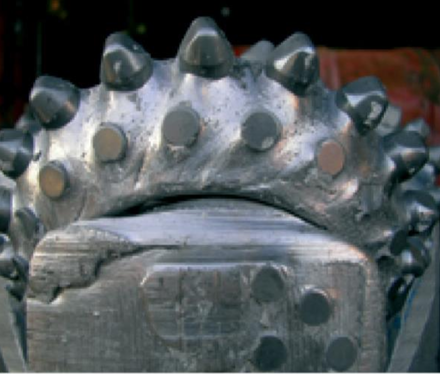
Examination: Cone steel erodes away around the inserts and results in loss of inserts. Also, excessive leg erosion can result in loss of inserts on the legs and in shirttail wear, air passage opening and loss of cone.
Causes:
- High abrasiveness of the formations drilled.
- Inadequate air volume flowing through the nozzles.
- Wet (from either ground water or excessive water injection) stick and abrasive formations.
Recommendation:
- Select WOB and RPM to achieve maximum ROP.
- Inspect air supply system for leakage.
- If dust control is used, reduce water supply. Make sure the nozzles are not plugged.
- Inspect cuttings removal efficiency.
- Increase nozzle size to reduce air pressure.
Cracked Cone (CC)

Examination: The cone cracks either axially or circumferentially.
Causes:
- Cone steel fatigue.
- Cone interference making the cone heat and generate cracks.
- Excessive WOB.
- Dropped drilling rod.
Recommendation:
- Reduce WOB.
- Review the drilling applications and make sure that the bit drills the bottom hole smoothly with no impacts.
- Monitor and control the wear of drilling rod threaded joints.
Lost Cone (LC)

Examination: Cones are left at the bottom hole.
Causes:
- The bit was over-drilled.
- Bit shock problem, bit cross-threaded (bit not square) bent rod.
- Bearing failure (all rollers and balls fell out).
Recommendation:
- Observe instructions in the bit manual.
Cone Interference (CI)

Examination: Bearing wear results in the teeth (inserts) of one cone interfering with another cone. It often results in intermittent cone jamming and inserts deterioration and radial cone breakage.
Causes:
- Excessive WOB resulting in exaggerated bending movement of journals.
- Plugged air passages, as a result bearings are not properly cooled.
- Insufficient air volume supplied to the bearing.
- Running a bit in an under-gauge hole.
- Rollers and ball bearings fall out of cone.
Recommendation:
- Reduce WOB.
- Inspect drilling rods condition, their wear and deviation.
- Inspect drilling assembly bushings for wear.
- Check the back pressure valve availability as well as nozzles availability and proper selection.
Cone Dragged (CD)

Examination: All three cones are jammed. The cones have typical tracks (flats) caused by inserts sliding at the bottom hole
Causes:
- Drilling with the air compressor switched off or failed.
- Air supply stopped or is insufficient due to air hose tear or air leakage in the circulation system.
- A foreign object jammed between the cones.
- Bit balling up.
Recommendation:
- Repair and adjust the compressor.
- Eliminate air leakage.
- Follow the instructions in the bit manual.
Cored Bit (DR) - loss of nose cones

Examination: Formation is packed between the cones. It can be erroneously considered as the bearing being jammed.
Causes:
- Inadequate cleaning of the bottom hole.
- Running the bit in hole with the compressor being off.
- Drilling a sticky formation.
Recommendation:
- Increase the air flow rate by nozzles selection.
- Examine the bit regularly.
Balled-up Bit (BU)

Examination: Formation is packed between the cones. It can be erroneously considered as the bearing being jammed.
Causes:
- Inadequate cleaning of the bottom hole.
- Running the bit in hole with the compressor being off.
- Drilling a sticky formation.
Recommendation:
- Increase the air flow rate by nozzles selection.
- Examine the bit regularly.
Broken Leg (BL)

Examination: One or all three legs are missing. It often happens as a result of the operator’s error or equipment failure.
Causes:
- The drilling rod lost in the hole while tripping or repair.
- High abrasiveness of the formations drilled.
Recommendation:
- Periodically check the thread of the drilling rod. In case of a wear or thread damage replace the thread connection.
- Select the optimal nozzle diameter.
Pinched Bit (PB) - Mechanically damaged bit
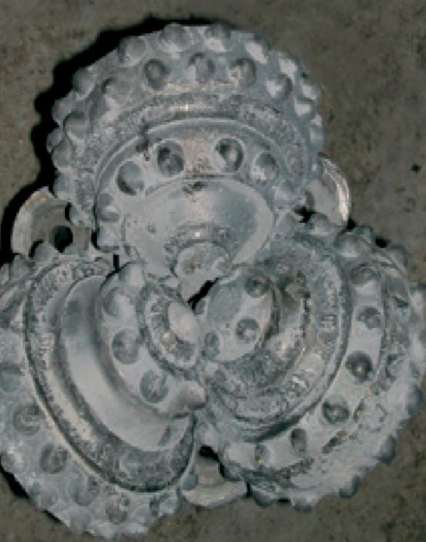
Examination: Inserts of inner rows are chipped. Between the rows of one cone there are traces of the adjacent cone.
Causes:
- Re-drilling with a new bit.
- Cleaning out the holes with a new bit.
Recommendation:
- Redrill a new hole adjacent to old one.
Plugged Nozzle (PN)

Examination: A nozzle is plugged with cuttings or rubber hose scraps. The compressor discharges air through the valve. There is a significant erosion of the bit shirttails and legs.
Causes:
- The bit was left at the bottom hole with air off.
- The bit valve protecting from cuttings failed or is missing.
- Material accidently in drill string.
Recommendation:
- Adjust the compressor, eliminate air leakage, clean the bit from cuttings (nozzles and air passages in the legs).
- Flush the drilling rod with air before screwing the bit on.
Lost Nozzle (LN)

Examination: A lost nozzle usually results in a sharp pressure drop.
Causes:
- Incorrect nozzle installation.
- Mechanical damage of nozzles or their retention system.
- Nozzles or their fixture erosion.
- Bit balling up.
Recommendation:
- Examine the bit regularly.
Off-center wear (OC)

Examination: Excessive wear of one or two legs (legs, shirttails); of one or two cones (gauge and hill rows), along with bearings failure; cones jammed and balls and rollers lost.
Causes:
- The drilling rod is bent which results in off-center bit rotation (radial runout).
- Hoisting jack has failed.
- The bit is cross threaded, the bit thread is damaged.
- The thread of the sub (box) is not cut properly, the thrust face of the sub does not thrust against that of the bit.
Recommendation:
- Check the drilling rod rotation for eccentricity.
- Check the bit for damaged thread.
- Check and replace the bit sub if its thread is damaged.
Shirttail Damage (SD)

Examination: Leg shirttail protecting the bearing is broken.
Causes:
- Axial part of the load on the bearing results in the shirttail bearing a part of the load.
- Axial runout when the bit rotates.
- Erosion weakens the shirttail structure.
Recommendation:
- Reduce WOB and select a bit with a smaller journal angle and bit axis.
- Check the bit for off-center wear and the drilling rod for a bend.
- Check the bit thread and the sub thread for damage.
- Check the drilling rod, compressor and the air line for leakage.
Bearing Sludging (BS)

Examination: Sludge in the bit bearing (it can be erroneously considered as jammed bearing).
Causes:
- Insufficient compressor capacity.
- Improper nozzles selection
- Drilling without the relief valve.
- The bit was left at the bottom of the hole for a long time with the compressor off.
Recommendation:
- Select the nozzles according to recommendations.
- Do not leave bit down hole with the compressor off.
- Run the bit with a relief valve in place.
Section 5 - Selection of efficient bit designs.
It is important to select efficient bit designs for specific mining and geological applications to ensure the best performance (reduced expenses for drilling equipment and drilling operations, increased drilling rigs productivity, reduced time for blast blocks preparation). Our specialists give all recommendations on the optimum bit types and sizes selection and analyse the efficiency of bit runs.
Efficient bit selection at each mining company is made based on a complex assessment of:
- Mining, geological and technological drilling applications
- Rock bit statistics
- Dull bit analysis
- Cutting structure and design features
- Technical and economic indices of bits performance based on test results. If necessary, we can design and manufacture rock bits based on our customer’s specific requirements.
5.1 - Mining and geological applications analysis
A critical factor that affects bit performance is the mining and geological applications analysis. Rock properties, namely uniaxial compression strength δ, average formation hardness factor F as per professor Protodyakonov’s scale, alteration, stringers, attitude of beds, water cut, abrasiveness, broken formations, etc. determine rock bit specification and design features.
Since geology may alter with a mine deepening and widening, it is important to consider the drilling volume as per “Long Term Drilling Operation Plan”.
5.2 - Technological applications analysis
Intensive mining complex development is directly related to technical re-equipment and replacement of drilling rigs. Such technical characteristics of drilling rigs as drilling performance, drilling assembly, connecting thread, compressor capacity should match the design features of bits. It is obvious, that it is impossible to achieve a considerable economic effect in drilling using the state-of-the-art bits with old and worn drilling rig. At the same time, it is well possible to reduce drilling expenses by selection of bits efficiency of which would match actual drilling rig technical parameters.
5.3 - Bit performance statistics analysis
The evaluation database for an efficient bit design selection is the Rock Bit Performance Statistics Analysis. Modern drilling companies usually use a few bit types of different manufacturers and it is important to make a comparative assessment of their efficiency disregarding the bits cost.

If the meterage and ROP of two bits are equal then the bits are equal in their efficiency.
5.4 - Dull bit analysis and reasons bit failed
After assessment of bits efficiency based on statistics, it is necessary to make a comparative analysis of each bit type dulling and reasons. The analysis results are important because it is critical to very precisely identify what bit design features are required for the application.
5.5 - Bit cutting structure and bearing design features analysis
As a rule, to select bits for optimization of their design features, drilling specialists in mining companies use bits identification method based on the data provided by manufacturers. It is a list of products at websites and in catalogues with bits specifications. The information contains alphabetic characters as per GOST 20692-2003 and the designation as per IADC code.
5.6 - Analysis of technical and economic indices of bits performance based on field test results
A bit design efficiency is determined based on comparative test results in equal mining and geological conditions. An efficient bit design should be considered the one that ensures the minimum value of operational expenses for drilling one running meter of a hole which is determined by the formula:


